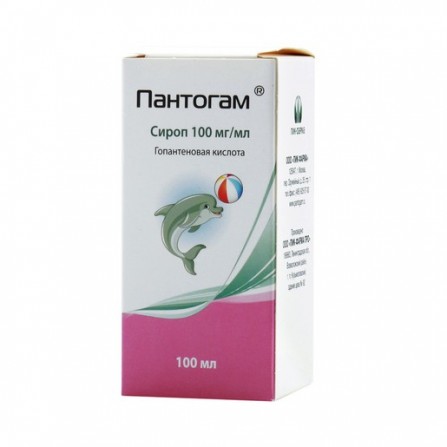More info
Active ingredients
Hopantenic acid
Release form
Syrup
Composition
Active ingredient: calcium hopantenate (Pantogam) - 10.0 g, excipients: glycerol (in terms of 100%) 25.8 g, sorbitol 15.0 g, citric acid monohydrate 0.1 g, sodium benzoate 0.1 g , aspartame 0.05 g, food flavoring “Cherry 667” 0.01 g, purified water - up to 100 ml.
Pharmacological effect
Nootropic agent, has neurometabolic, neuroprotective and neurotrophic properties. It increases the resistance of the brain to hypoxia and the effects of toxic substances, stimulates anabolic processes in neurons, combines a moderate sedative effect with a mild stimulating effect, has an anticonvulsant effect, reduces motor excitability with simultaneous ordering of behavior. Enhances mental and physical performance. It contributes to the normalization of GABA in chronic alcohol intoxication and the subsequent abolition of ethanol. Shows analgesic effect.
Pharmacokinetics
After ingestion is rapidly absorbed in the digestive tract. Tmax - 1 hour. The highest concentrations are in the liver, kidneys, in the wall of the stomach and skin. Penetrates the BBB. Not metabolized. It is excreted unchanged within 48 hours: 67.5% of the dose taken - with urine, 28.5% - with feces.
Indications
Children with perinatal encephalopathy from the first days of life. Different forms of cerebral palsy. Mental retardation of varying severity, including behavioral disorders. Violations of the psychological status of children in the form of a general mental retardation, specific speech disorders, motor functions and their combination the formation of school skills (reading, writing, counting, etc.). Hyperkinetic disorders, including attention deficit hyperactivity syndrome. Neurosis-like states (with panying primarily clonic form, ticks, inorganic encopresis and enuresis) .Snizhenie mnestiko-intellectual productivity due to arteriosclerotic changes in cerebral vessels, while the primary forms of senile dementia, organic brain damage of traumatic, toxic, neyroinfektsionnogogeneza. Schizophrenia with cerebral organic deficiency (in combination with psychotropic drugs). Extrastrapyramidal disorders in organic brain diseases (myoclonus epilepsy, Huntington's chorea,hepatolentic degeneration, Parkinson's disease, etc.), as well as for the treatment and prevention of extrapyramidal syndrome caused by the administration of neuroleptics. Epilepsy with slowing mental processes and a decrease in cognitive productivity with anticonvulsants. Psycho-emotional overload, reduced mental and physical performance, to improve concentration and memorization. Neurogenic disorders of urination (pollakiuria, imperative urges, imperative urinary incontinence).
Contraindications
Hypersensitivity to the drug, acute severe kidney disease, pregnancy (1 trimester), phenylketonuria (syrup contains aspartame).
Use during pregnancy and lactation
Use in the first trimester of pregnancy is contraindicated.
Dosage and administration
4 Pantogam syrup 100 mg / ml is taken orally in 15-30 minutes after eating. A single dose for adults is usually 2.5 - 10 ml (0.25 - 1 g), for children - 2.5 - 5 ml (0.25 - 0.5 g); the daily dose for adults is 15-30 ml (1.5 - 3 g), for children - 7.5 - 30 ml (0.75 - 3 g). The course of treatment is 1 - 4 months, sometimes up to 6 months. After 3 - 6 months, it is possible to repeat the course of treatment. Depending on the age and pathology of the nervous system, the following dose range is recommended for children: children of the first year - 5 - 10 ml (0.5 - 1 g) per day, up to 3 years - 5 - 12.5 ml (0.5 - 1.25 g) per day, for children from 3 to 7 years old - 7.5-15 ml (0.75 - 1.5 g), older than 7 years old - 10 - 20 ml (1 - 2 g). The treatment tactics involves increasing the dose within 7 to 12 days, taking the maximum dose for 15 to 40 days or more, with a gradual decrease in dose until withdrawal within 7 to 8 days. The course of treatment is 30 - 90 days (for certain diseases up to 6 months or more). With schizophrenia in combination with psychotropic drugs - from 5 to 30 ml (0.5 - 3 g) per day. The course of therapy is from 1 to 3 months. With epilepsy in combination with anticonvulsants - in a dose of 7.5 to 10 ml (0.75 - 1 g) per day. The course of therapy is up to 1 year or more. In neuroleptic syndrome, accompanied by extrapyramidal disorders, the daily dose is up to 30 ml (up to 3 g), treatment for several months. When extrapyramidal hyperkinesis in patients with organic diseases of the nervous system - from 5 to 30 ml (0.5 - 3 g) per day. The course of treatment is up to 4 months or more. With the consequences of neuroinfections and head injuries - from 5 to 30 ml (0.5 - 3 g) per day. To restore health at increased loads and asthenic conditions, 2.5-5 ml (0.25-0.5 g) 3 times a day are prescribed to pantogs.5 For urination disorders in children, 2.5 to 5 ml each (0.25 to 0.5 g), the daily dose is 25 to 50 mg / kg, the course of treatment is 1 to 3 months; adults, 5 to 10 ml (0.5 to 1 g), 2 to 3 times a day. In conditions of long-term treatment, simultaneous administration of the drug with other nootropic and stimulating agents is not recommended. Taking into account the nootropic effect of the drug, its administration is preferably carried out in the morning and afternoon hours.
Side effects
Allergic reactions are possible (rhinitis, conjunctivitis, skin allergic reactions). In this case, the drug is canceled. Adverse reactions from the central nervous system (hyper-stimulation, sleep disturbance or drowsiness, lethargy, lethargy, headache, dizziness, noise in the head) are very rare. In this case, reduce the dosage.
Interaction with other drugs
It prolongs the effect of barbiturates, enhances the effects of anticonvulsants, nootropic and CNS stimulating agents, the action of local anesthetics (procaine). It prevents the side effects of phenobarbital, carbamazepine, antipsychotics (neuroleptics). The effect of hopantenic acid is enhanced in combination with glycine, ksifiponom.
special instructions
Long-term therapy with hopantenic acid in combination with other nootropic and CNS-stimulating agents is not recommended.





